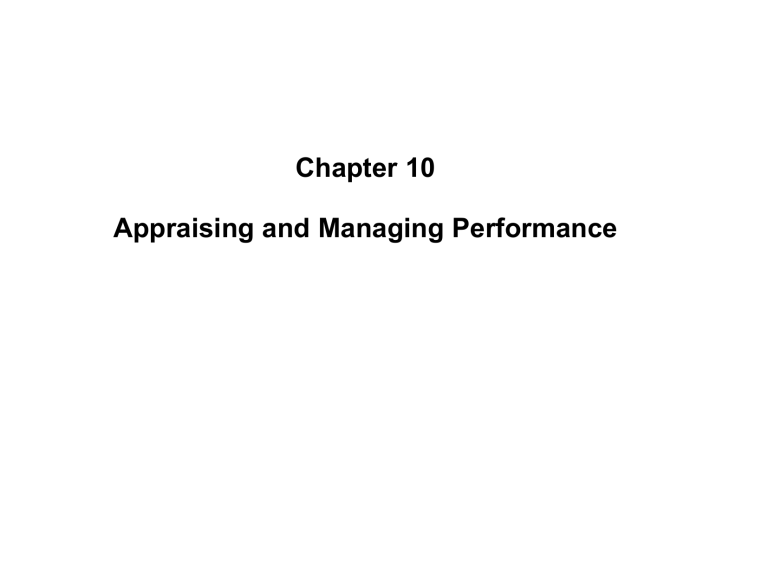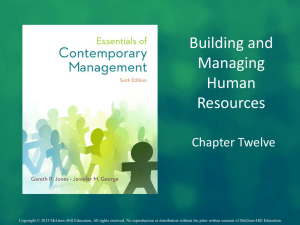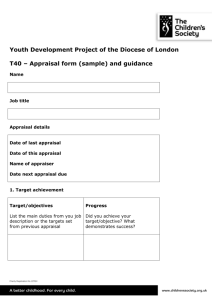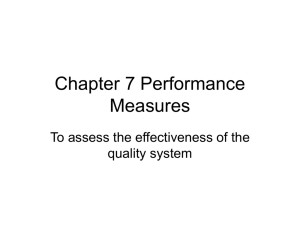lecture_15
advertisement

Chapter 10 Appraising and Managing Performance Lecture Overview • Performance Appraisal • Relationship between Performance Appraisal and Job Evaluation • Objectives of Performance Appraisal • Multi Purposes of Performance Appraisal • Performance Appraisal and Competitive Advantage • Process of Performance Appraisal • Performance Appraisal Methods • Goal Based Performance Appraisal • 360 Degree Performance Appraisal Recap of Previous Lecture • Training Process • Phases in Training Process • Steps in Training Program • Training Methods • Training and HRD Training Process Need Assessment a) Organization support b) Organizational Analysis c) Task and KSA analysis d) Person Analysis Development of criteria Instructional Objectives Training Validity Transfer Validity Selection and design of instructional program Intraorganizational validity Training Interorganizational validity Source: Aswathappa, 2008, p. 216 Use of evaluation models Training Process Phase 1 Training Need Phase 4 Training Evaluation Phase 2 Training Design Phase 3 Training Implementation Training Methods Training Method Orienting new employees, introducing innovation Special skills training Safety education Creative technical and professional education Sales, administrativ e and managerial education Orientation training Yes - - - - Job Instruction training Yes Yes - - - Apprentice training Yes Yes - - - Internship - Yes - Yes Yes Job rotation Yes - - - Yes Coaching - Yes Yes Yes Yes On the job Source: Aswathappa, Human Resource Management, Text and Cases, 2008, p. 221 Training Methods Training Method Orienting new Special skills employees, training introducing innovation Safety education Creative technical and professional education Sales, administrative and managerial education Vestibule Yes Yes - - - Lecture Yes Yes Yes Yes Yes Films Yes Yes Yes Yes Yes Conference Yes - Yes Yes Yes Case Study - - - - Yes Role Playing - - - Yes - Simulation Yes Yes Yes Yes - Programmed Instructions Yes Yes Yes Yes - Laboratory Training - - Yes Yes - Off the job Source: Aswathappa, Human Resource Management, Text and Cases, 2008, p. 218 Training Process 1 Training Need Assessment Organizational Analysis 1 How training will assist to achieve organization goals? 2 What cost is expected and what is benefit to the organization? Task Analysis 1 What are job responsibilities and duties? 2 What knowledge and skills are required to increase work performance? Person Analysis 1 What is trainee's skill and knowledge level? 2 Which learning style trainees prefer? Training Process 2 Training Design Instructional Objectives/strategy 1 Based on TNA, learning objectives are set (desired skills and knowledge and attitude change) 2 This includes detailed plan regarding methods, material, resources and training objectives etc. Trainee Readiness 1 Assessment of trainee's background knowledge and skills to determine level of readiness to absorb new learning 2 Knowledge of level of trainee to develop contents/strategy of training program 3 Categorizing and grouping trainees according to their capacity to learn 4 To enforce and motivate trainee's desire to learn new knowledge and skills Training Process 2 Training Design Learning Principle 1. Setting training goals and objectives 2. Meaningful presentation 3. Social learning theory focusing on learning based on modeling and visual aids 4. Appreciate differences in learning style; some learn quickly in group discussion while some prefer to work alone on problems 5. Practice and Practice (Exercises/work on solutions) 6. Feedback on progress 7. Time duration (continuous or distributed) 3 Training Implementation Material and Equipment Posters and Charts Whiteboard/Projector Trainee's Manual 1. Contains Information on Training Content Trainer's Manual Contains information given in trainee's manual and instruction on how to deliver Facilities 1. computer/furniture/training room Trainer 1. Who will deliver the training? 2. Trainer's qualification, experience, expertise and background Training Process 4 Training Evaluation Reactive 1. Did the trainees find the training interesting (Questionnaires)? Immediate feedback response on training Learning 1. Did the trainees have made advancement in knowledge and skills (written test)? Behavior 1. Is trainee behaving in different way after receiving training (performance appraisal) Results 1. Is organization/unit performing better (Quality/Productivity/Cost/ Profit/Morale/Work environment/team work Source: Blanchard, P. & Thacker, J: Effective Training, Systems, Strategies, and Practices (3rd Edition, 2007) Definition of HRD “A set of systematic and planned activities designed by an organization to provide its members with the necessary skills to meet current and future job demands” Werner and DeSimone (2006) Relationship Between HRM and HRD • Human Resource Management (HRM) covers many functions • Human resource development (HRD) is just one of the functions within HRM HRD Functions • Training and development (T&D) • Organizational development • Career development Training and Development (T&D) • Training – improving the knowledge, skills and attitudes of employees for the short-term, particular to a specific job or task • Development – preparing for future responsibilities, while increasing the capacity to perform at a current job Organizational Development • The process of improving an organization’s effectiveness and member’s well-being through the application of behavioral science concepts Career Development • Ongoing process by which individuals progress through series of changes until they achieve their personal level of maximum achievement Werner and DeSimone (2006) Appraising and Managing Performance Performance Appraisal • Performance appraisal is to evaluate the performance of an employee to determine whether he is performing his given task and duties well or to monitor whether he has given his best effort and performance on given job • Performance appraisal is an assessment of individual performance, the performance is measured against such factors as job knowledge, quality, quantity of output, initiative, leadership, abilities, supervision, cooperation, judgment, analytical skills, problem solving skills, etc. (P. 239) • The other similar terms often used for performance appraisal are performance rating, employee performance review, employee assessment, personal appraisal, employee evaluation, or performance evaluation Performance Appraisal Job Analysis Describe work and professional requirement of a job Performance Standards Translate job requirements into levels of acceptable or unacceptable performance Performance Appraisal Describe the job relevant strengths and weaknesses of each individual Relationship of Performance Appraisal and Job Analysis Source: Aswathappa, Human Resource Management, Text and Cases, 2008, p. 240 Objectives of Performance Appraisal • Make promotion decisions based performance • To confirm services of employee on probation • To identify training and development needs of employees • To decide compensation • To inform employees of their performance and give them feedback and guidance to improve performance • Performance appraisal helps to know the effectiveness of other HR functions such as recruitment and selection, training, and promotion etc. Multi Purposes of Performance Appraisal Administrative Developmental Set selection criteria Identification of individual training needs Promotion Performance feedback Retention or termination Determining job assignment and transfer Identification of poor performers Identification of strengths and weaknesses of employee Compensation Recognize and appreciate individual performance Evaluate training effectiveness Goal setting and evaluation Adopted from: Aswathappa, Human Resource Management, Text and Cases, 2008, p. 240 Performance Appraisal and Competitive Advantage Improving performance Making correct decisions Consistency between strategy and behavior Competitive advantage Minimizing dissatisfaction and turnover Ensuring legal compliance Adopted from: Aswathappa, Human Resource Management, Text and Cases, 2008, p. 240






